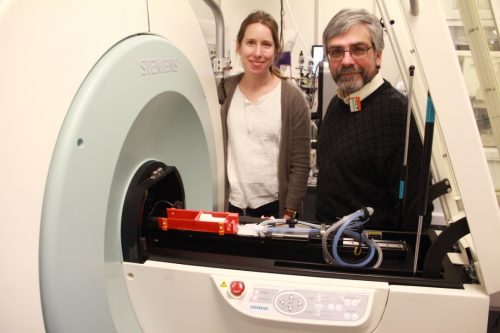Beyond the dramatized experiences shown in movies like Finding Nemo and Madagascar, most people have only vague notions of what goes through the mind of a captured animal. Yet while captivity is certainly not ideal, animal capture is critical to conservation efforts focused on population growth or animal rehabilitation. Moreover, research using captured animals often has implications for humans. Captured and freely living wild animals exhibit many differences in behavior and physiology, but up until recently there has been little research on the root causes of these differences. Using captured wild sparrows, researchers led by Professor Richard Carson, Director of the Yale Positron Emission Tomography (PET) Research Center, have shed light on a stress hormone that may play a key role in some of the negative behavioral responses that occur in captivity. Their research suggests that the caged bird—or any caged animal—truly becomes a different sort of beast through the experience of captivity.
It has long been recognized that captured and wild animals exhibit marked differences in body composition as well as in patterns of behavior such as breeding, eating, and aggression. The standing hypothesis has been that chronic stress and increased stress hormone triggered by a new environment induce these changes in captured animals. The most commonly implicated hormone is corticosterone, the primary long-term stress hormone in birds, though no study has previously tested this link. Corticosterone itself exists in two forms: a baseline form that is necessary for normal bodily function and a stress-induced form that arises from stressors such as predators or human contact.
Left unchecked, stress and its associated hormonal changes can have dramatic impacts on the physiology and behavior of animals. “There’s some evidence that wild animals may never fully habituate to the stress of a captive environment, and in some cases they may actually shift into a new state,” says Dr. Christine Lattin, first author of the study and post-doctoral fellow at the Yale PET Center. The animals may never return to their original physiological state, even after a long period of time in captivity.
In testing the relationship between stress activation and physical changes, the Yale researchers manipulated corticosterone levels in captured wild house sparrows. One group of birds was treated with injections of the drug mitotane, which inhibits the production of stress-induced corticosterone. The other group received injections of a placebo drug. Using CT imaging, various tissues were visualized at initial capture and at the end of two weeks. Corticosterone titers within the blood were also measured in response to stress. Bird behavior was analyzed using video recordings.
At the end of two weeks, both groups had experienced significant changes in organ size, and while mitotane did not mitigate physiological changes, it did reduce stress-related behavior and corticosterone release in response to stress. Birds are known for undergoing rapid tissue remodeling in response to changing environments. The sparrows showed decreased heart volume, increased fat storage, and decreased density, but not thickness, of their major flight muscle, indicating that the muscle was being replaced by fat.
The most compelling reason for the observed tissue remodeling comes from the behavior of the captured birds. During their two weeks in captivity, the control sparrows increased their frequency of beak-wiping, a well-known stress behavior in birds, as well as other stress behaviors. The story was different for mitotane-treated birds, which engaged in much less beak-wiping, and which showed reduced plasma corticosterone in response to stressors such as human contact.
These findings are important because they reveal a potentially confounding influence of stress in behavioral studies using captured animals. They also hint at evolutionary reshaping that occurs in breeding captured animals for either domestication or research.
“Anytime you breed animals in a captive environment you are actually altering the stress response [of the population as a whole] because only the more stress-tolerant individuals will breed,” says Dr. Lattin. This individual variation in resiliency during stress is a principle that holds true for both animals and humans.
Dr. Lattin notes that the study can serve as a “paradigm” for chronic stress that has been previously unexplored in biomedical research. The next frontier for the lab is dopamine, which has also been shown to play a role in the stress response in addition to its function in reward signaling.
Future studies using PET to quantify and analyze dopamine receptors and dopamine-corticosterone interactions will continue to increase our understanding of the life of the caged bird.

